
The Series has been brought to you to highlight local country towns in the South of Victoria.
Point Cook
Point Cook was originally spelled Point Cooke, and named in 1836. Almost all references dropped the "e"; however, in the early 2000s the point itself was officially renamed "Point Cooke". Point Cook was named after John M. Cooke, mate of His Majesty's vessel Rattlesnake. Commanded by Captain Hobson, the ship charted part of the Port Phillip bay in 1836.
William Drayton Taylor leased the land around Point Cook promontory in 1849. The following year in 1850 Taylor transferred his licence to Alexander Irvine. By March 1852, a six-room weatherboard cottage had been erected.
In 1853 the pastoralist Thomas Chirnside added the farmlands of Point Cook to his holdings. He built the famous Point Cook Homestead of twenty-five rooms in 1857. The Chirnsides became one of Victoria's prominent pastoral families, entertaining the colonial gentry and organising sporting functions for their guests at Point Cook. In 1873 the Chirnside brothers began construction of the elaborate mansion at Werribee Park. By 1877 the Werribee Park Mansion had been completed and it largely displaced the Point Cook Homestead as their families' focus.
In 1912 the Federal Government purchased a large section of Point Cook with a vision to establish the Australian Flying Corps (AFC). Point Cook is considered the birthplace and the spiritual home of the RAAF. Today the RAAF Williams base is the home of the RAAF College including Officers Training School (OTS) and the RAAF Museum. In 1948 Point Cook hosted the Australian Grand Prix, which was held at the Point Cook RAAF Base. The race was won by Frank Pratt driving a BMW 328.
Cheetham Salt established a series of ponds in the 1920s where sea water was fed into the shallow ponds and allowed to evaporate. Dried salt was then harvested from the floor of the lagoons. This operation continued until the early 1990s, when the site was purchased by the Victorian Government. The more environmentally important bayside part of the original saltworks now comprises Cheetham Wetlands which make up the migratory bird habitat and conservation area that is there today.
In 1996, Point Cook was basically a rural community, with the RAAF (Royal Australian Air Force) Williams Base. Point Cook's population in 1996 was approximately 580, of whom 552 lived on the RAAF base. By 2001, Point Cook’s population had increased to 1,737, and by August 2006 the population of Point Cook was 14,162 as per the 2006 Australian Census. Today Point Cook is one of the major growth regions in Melbourne's western suburbs.
Source: Wikipedia
This cache is a Letterbox Hybrid. - So what is it?
Letterboxing is another form of treasure hunting that uses clues instead of coordinates. In some cases, the letterbox owner has made their container both a letterbox and a geocache and posted its coordinates on Geocaching.com. These types of geocaches will contain a stamp that is meant to remain in the box and is used by letterboxers to record their visit.
Please remember that the stamp must remain in the cache, it is not swag and your fellow geocachers will get very sad if you take it home with you.
